Abstract
This controlled parent-targeted drug prevention intervention followed two cohorts of students to determine the effect of encouraging parents to intervene in risk factors for adolescent tobacco and alcohol use. Suggestions included limiting association with substance-using peers and asking parents to limit adolescent access to alcohol. Although student participation and retention in the study was good parent participation was poor. Parents were unlikely to know whether their children had substance-using friends and there was no impact on adolescent substance use. However, parent monitoring of children's whereabouts, maintaining high rapport and a respectful parent-child relationship did protect against adolescent substance use. Future parent-targeted prevention programs should target protective factors, rather than trying to control risk factors.
Introduction
Several studies have shown that having substance-using peers is the strongest risk factor for the onset of adolescent drug use (Flay 1987; Hansen et al. 1987; McAlister, Perry, and Maccoby 1979; Pentz et al. 1989). Parental influence is also important, and some researchers believe it plays an even greater role than does peer influence, because parents lay the foundation that directs a child to associate or not to associate with substance-using peers (Shedler and Block 1990; Pulkininen 1983). We hypothesized that parents might be able to directly prevent their children from experimenting with substances if they knew their children's friends and could limit associations with substance-using peers. Further, if parents improved communication with the parents of their children's friends, they might establish norms of abstinence that could be enforced by all parents in their children's friendship groups (Hansen et al. 1987). A program to test this hypothesis was developed and delivered in conjunction with an existing school-based prevention program, components of which have been shown to be effective in reducing onset of tobacco and alcohol use in controlled intervention trials (MacKinnon et al. 1991; Bangert-Drown 1988; Botvin and Wills 1985).
Previous drug prevention programs that have attempted to involve parents have been fraught with difficulties. These include low participation, selection bias, and ceiling effects due to participation of parents who were already managing their children appropriately (DeMarsh and Kumpfer 1985; Albert, Simpson, and Eaglesham 1983). Other interventions have been developed and tested with relatively small numbers, so that the issue of generalizability was still a concern (Klein and Swisher 1983; Klitzner, Gruenewald, and Bamberger 1990). One researcher suggested interventions so intensive that they are not feasible to conduct on a scale necessary to reach the large number of families in need (Laudeman 1984).
This program sought to address these drawbacks by implementing the program in public schools, targeting all parents of enrolled students, replicating the program in two independent cohorts, and collecting repeated measures of students and parents over time.
Methods
Procedure
Two school districts in Los Angeles were recruited to participate in this parent-targeted drug prevention program. Criteria for participation included the presence of a comprehensive drug prevention curriculum for fifth- and seventh-grade students. The schools were then randomly assigned to control and treatment conditions based on the ethnic mix, socioeconomic status (percentage of children on free lunch program), and achievement scores. All students enrolled in participating district schools were eligible as subjects and could participate only if they had active parental consent. Parents of all enrolled students were asked to participate by answering parent surveys. Students delivered notices explaining the survey, including a government guarantee of confidentiality to parents. At least three attempts were made to obtain verbal consent from parents who did not return a signed consent. Surveys were then sent to parents through their children. Parents who did not return a completed survey received additional copies in the mail with return postage. Up to three follow-up phone calls were made to remind parents to complete the questionnaires.
Only parents of students in treatment schools were invited to attend the three evening intervention sessions. Attendance sheets were completed. Families were counted only once, even if both parents attended.
Program Components and Rationale
The program consisted of four sessions for Cohort 1 and three evening sessions for Cohort 2. One session on improving communication between parents and children was eliminated for the second cohort in that it appeared to contain too much material with not enough time for parents to master the related skills.
Session One
The first session was meant to enlist the largest number of parents. Both children and parents were invited to participate, because parents would-be more likely to attend with their children, particularly if their children were participating in the program (Laudeman 1984).
During the first session, students demonstrated drug refusal skills to be used to counter peer pressure. In a “round robin,” parents and students were directed to get to know each other and share their thoughts about drug use by responding to pertinent questions, such as “Do friends really influence people to use drugs? If so, how?”; and “Have you ever been in a situation where you said ‘yes’ to something when you really wanted to say ‘no’? If so, when?”
A list of “friendship circles” identifying groups of students who seemed to associate with each other was distributed. Students had completed a list of their 10 best friends in school, and by way of a correlation matrix, we were able to cluster a group of 5 to 15 students who had named each other as best friends. The few children who were not named were put into one of the larger groups of students. The list was distributed with the disclaimer that the groups might not be completely accurate, but that parents could use these lists as a basis for starting to identify and familiarize themselves with their children's friends. As an activity, students and parents were asked to create a telephone directory of their friends and friends' parents. Last, a workbook that summarized the session and listed activities and suggestions that might help parents keep their children drug-free was distributed. Workbooks and lists of friendship circles were mailed to parents who did not attend the session.
Session Two
Parents were invited to attend the second session without their children and to meet in friendship circles so that parents whose children were friends could get to know each other. The setting was more informal, either a host parent's home or a comfortable environment such as the school library or staff room. During this session, a facilitator led an interactive discussion that covered changes associated with adolescence, strategies that adolescents frequently use to manipulate parents and how parents could prevent such manipulation, issues related to the development and enforcement of rules, and general sharing of child-rearing practices that seemed to be useful for participants.
Session Three
In the third session, the parents were to meet again in their friendship circles and, with the help of a facilitator, discuss issues relating to alcohol use and, if possible, develop a consensus on them. Those issues included abstinence versus responsible use of alcohol, access to parents' liquor cabinets, unchaperoned events, and curfews.
Recruitment Procedures—Intensity of Intervention
Given that program participation is enhanced by personal contact, endorsement by peer leaders, and involvement of children (Laudeman 1984), we used several procedures in each school to maximize attendance. We met with the principals, PTA presidents, and PTA boards. We announced the program at “Back-to-school” nights and made it clear that the focus would be a drug prevention effort to help parents better monitor their children. We emphasized that parents would meet their children's friends and the parents of these friends. Parents were recruited to participate in phone trees and to remind other parents to attend. Reminder flyers were sent home with students about 2 weeks and 1 to 2 days before the evening sessions. For schools in which principals deemed it important, we provided child care services and/or translators. For the friendship circle meeting, the parents who had volunteered to host the session in their home or at the school personally called other parents in their circle to encourage them to attend.
Measures
Trained data collectors administered surveys to children in their classrooms. To encourage honest reporting, students were informed that all answers would be confidential. In particular, students were promised that their answers would not be disclosed to parents, teachers, or other authorities. Parent surveys were completed at home and returned in sealed envelopes through their children or by mail.
We obtained data regarding demographics and numerous aspects of parent-child relationships from the surveys. In addition, students were asked to report about ever using tobacco, alcohol, and other drugs (e.g., marijuana). Parents reported their own tobacco and alcohol use but were not asked to speculate about their children's drug use.
Separate principal component analyses were performed on the data collected from the child and parent surveys, and items that were not correlated with any component in both the parent and child scales were eliminated. Items that loaded together were standardized and averaged to form a summary scale. Reliability of the scales was good, with coefficient alphas similar for both parents and students, ranging from .60 to .86 for students and .51 to .87 for parents (see appendix). The parent behavior constructs were monitoring, a measure of how much the parents knew about their children's whereabouts; rapport, a measure of the time spent together and communication between parent and child; respect, a measure of positive relations, praise, and fair treatment of children; knowledge of children's friends; and parental consistency. The amount of children's household chores was measured, as well as children's risk-taking behavior and report of substance-using peers. Student and parent perceptions of whether children's peers used tobacco, alcohol, or marijuana and of parenting behaviors were compared. To determine predictors of the onset of tobacco and alcohol experimentation, students who already used substances at baseline were deleted from the analysis.
Surveys were administered to both parents and students at baseline, after the intervention (spring of the first year), and every year thereafter. The research design is diagrammed in Table 1.
Table 1. The Parent Program—Research Design.
| Intervention | Year 1 | Year 2 | Year 3 | Year 4 |
|---|---|---|---|---|
| Cohort 1 | O5,Xsc,XpsO5 | O6 | O7 | O8 |
| Cohort 2 | — | O7,XscXpsO7 | O8 | O9 |
| Control | ||||
| Cohort 1 | O5,Xsc,O5 | O6 | O7 | O8 |
| Cohort 2 | — | O7,XscO7 | O8 | O9 |
Note: sc = student drug prevention curriculum; ps = parent skills intervention.
Results
Sample Description
Cohort 1 was composed of 1,034 fifth graders recruited from 17 elementary schools. This represented 78% participation from a total of 1,322 eligible subjects. The gender distribution was 48% boys and 52% girls, and the ethnic distribution was 156 (15%) Asian, 335 (32%) Hispanic, 388 (38%) White, 37 (4%) Black, and 118 (11%) other/unknown. In Cohort 2, 1,244 seventh-grade students from seven junior high schools participated, representing 74% of 1,702 eligible subjects. The gender distribution was 50% boys, 50% girls, and the ethnic makeup was 180 (15%) Asian, 335 (27%) Hispanic, 494 (40%) White, 45 (4%) Black, and 171 (14%) other/unknown.
A baseline survey of the sample showed that 12% of fifth graders and 28% of seventh graders had tried cigarettes. Forty-one percent of fifth graders and 58% of seventh graders had tried alcohol. In Cohort 1, only 8 parents (1.3%) believed there was drug use among their children's friends while 62 students (11%) reported some drug use among friends. In Cohort 2, 38 parents (5%) and 208 students (26%) reported drug use among friends. By the last year of the study, combining the matched child-parent pairs of the two cohorts (eighth and ninth graders), 71 (19%) parents and 204 (55%) students reported substance use among the students' friends.
Participation/Attrition
The number of subjects and the rate of attrition are shown in Table 2. In both cohorts, several students who had returned parental consent forms after the classroom survey was administered in the fall were measured only in the spring of the first year. Compared with students who completed surveys throughout, students who had dropped out were more likely to be Hispanic and to have higher baseline tobacco use as well as more substance-using peers. Attrition among parents in both cohorts was high, with only 15% and 23%, respectively, of parents completing surveys at the last measurement. Parents with lower educational backgrounds and higher tobacco use were more likely to drop out.
Table 2. Participation and Attrition by Cohort.
| Measurement | 1 | 2 | 3 | 4 | 5 |
|---|---|---|---|---|---|
| Cohort 1 | 5th | 5th | 6th | 7th | 8th |
| Students | 1,034 | 1,088 | 771 | 721 | 717 |
| (%) | 100 | 105 | 75 | 70 | 69 |
| Parents | 941 | 811 | 439 | 219 | 139 |
| (%) | 100 | 86 | 47 | 23 | 15 |
| Cohort 2 | 7th | 7th | 8th | 9th | |
| Students | 1,244 | 1,114 | 986 | 856 | |
| (%) | 100 | 90 | 79 | 69 | |
| Parents | 1,127 | 396 | 291 | 264 | |
| (%) | 100 | 35 | 26 | 23 |
When comparing the self-reported parenting behaviors of parents who completed surveys throughout the study with those who dropped out, in Cohort 1 there were no striking differences in reported baseline parenting behaviors. In Cohort 2, (parents of seventh graders), parents who dropped out were less likely to monitor their children, spend time with them, and know their children's friends.
Attendance at Evening Sessions
In Cohort 1, only 52 parents actually attended at least one of the sessions. Of these, 38 (73%) parents also completed a survey. In Cohort 2, only 96 parents actually attended at least one of the sessions. Of these 96, 70 (73%) parents also completed a survey. Compared with attenders, parents who did not attend were more likely to be Asian and less likely to be married. There were no significant differences in self-reported parenting behaviors between attenders and nonattenders.
Substance Use Over Time
Throughout each year of the study, there were no differences in tobacco and alcohol use between control and study groups in either cohort, controlling for gender, ethnicity, and socioeconomic status, or using classroom or school as unit of analysis. Use of tobacco and alcohol increased annually in both groups. In Cohort 1, tobacco use increased from 9.6% to 37.9% between the fifth and the eighth grades, and in Cohort 2, it increased from 22.9% to 41.6% between the seventh and ninth grades. Among Cohort 1 students, experimentation with alcohol increased from 42.3% to 71.7%, while in Cohort 2, it increased from 55.4% to 72.8% (See Figures 1 and 2).
Figure 1. Onset of Smoking.
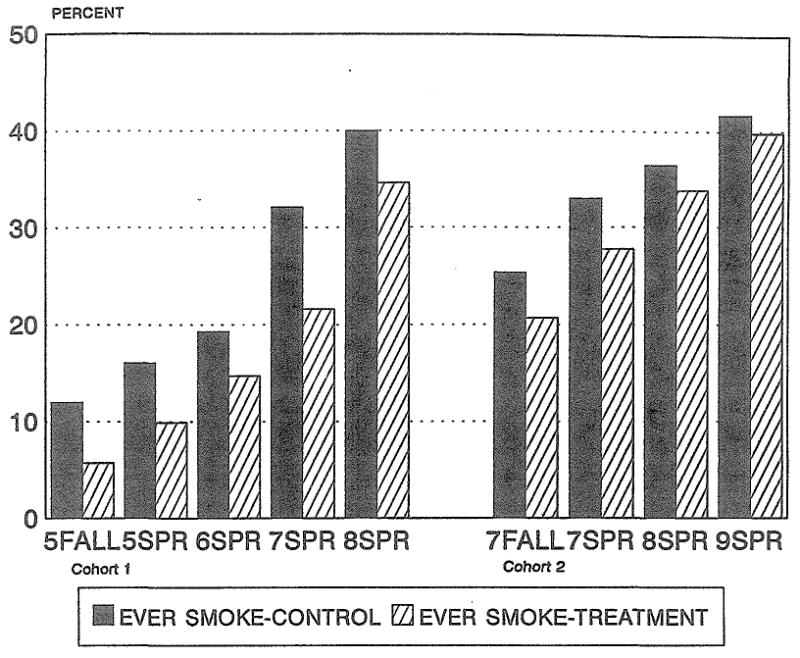
Figure 2. Onset of Drinking.
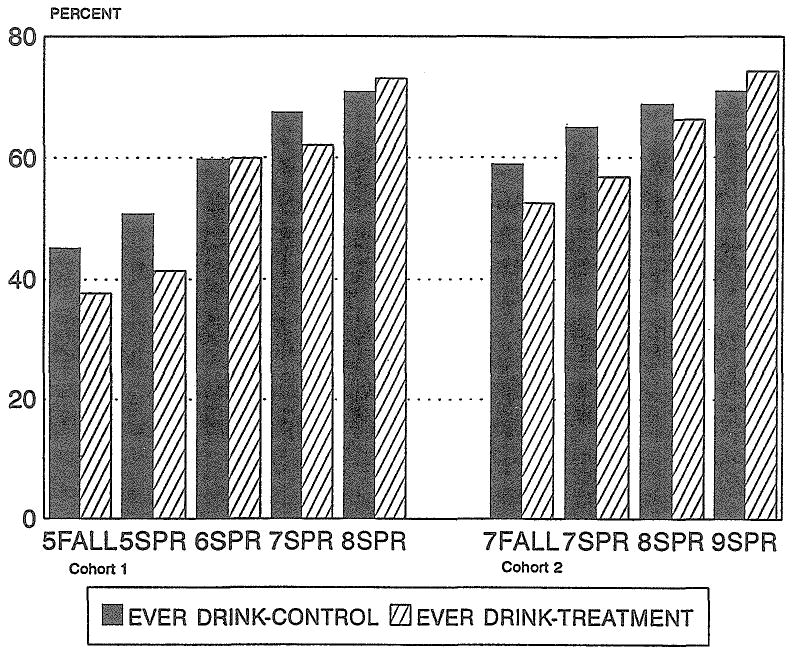
Parenting Behaviors
There were no significant differences between control and study groups in children's reports of parenting behavior over time. Among both cohorts and across both study and control groups, children's perceptions of monitoring, rapport, and respect tended to decrease over time. Knowing children's friends, household chores, and parental consistency were stable, while risk-taking behavior tended to increase over time (See Figure 3).
Figure 3. Longitudinal Change in Parenting Behaviors. Cohort 1 and Cohort 2.
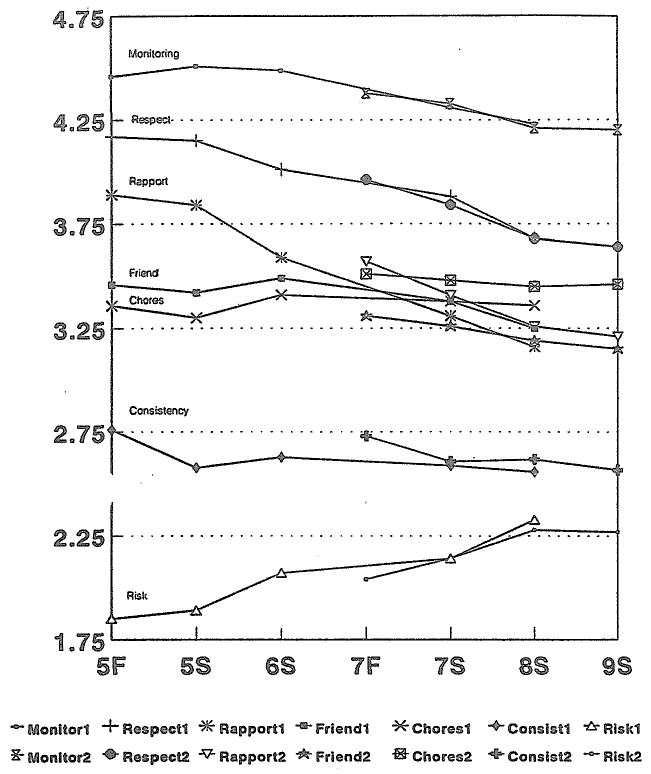
When children's perceptions of parenting behaviors were stratified by the onset of children's tobacco or alcohol use, children who became smokers or drinkers showed larger declines in parental respect (Figures 4a and 4b), parent rapport (Figures 4c and 4d), and parental monitoring (Figures 4e and 4f), compared with children who remained nonsmokers or nondrinkers. No differential declines occurred in how well parents knew children's friends over time among children who used tobacco and alcohol and those who did not (See Figures 4g and 4h). In contrast, parents whose children reported having substance-using peers consistently perceived their parent-child relationship as having higher indexes of rapport (p < .001), respect (p < .001), and monitoring (p < .001) than those reported by their children. The parent-child discrepancy was not as pronounced between parents and children whose peers did not use substances.
Figure 4.
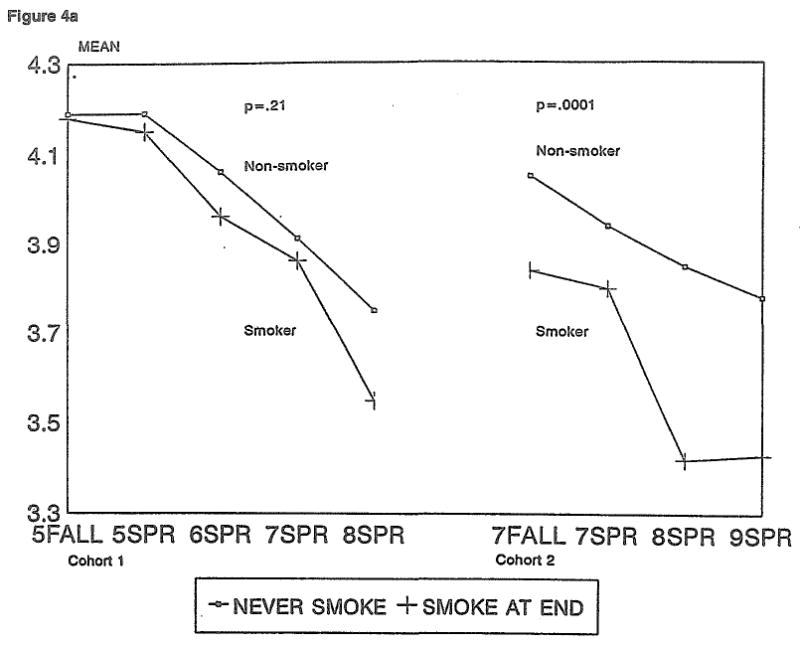


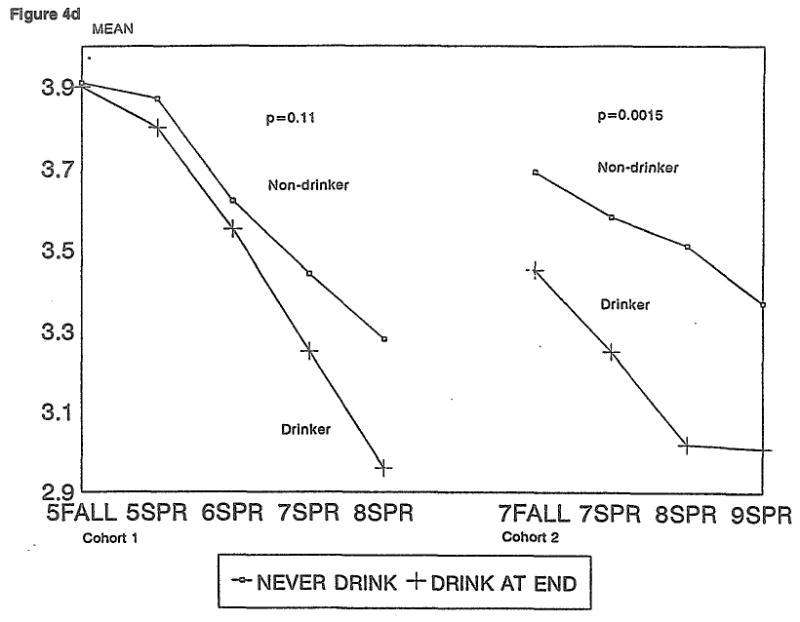
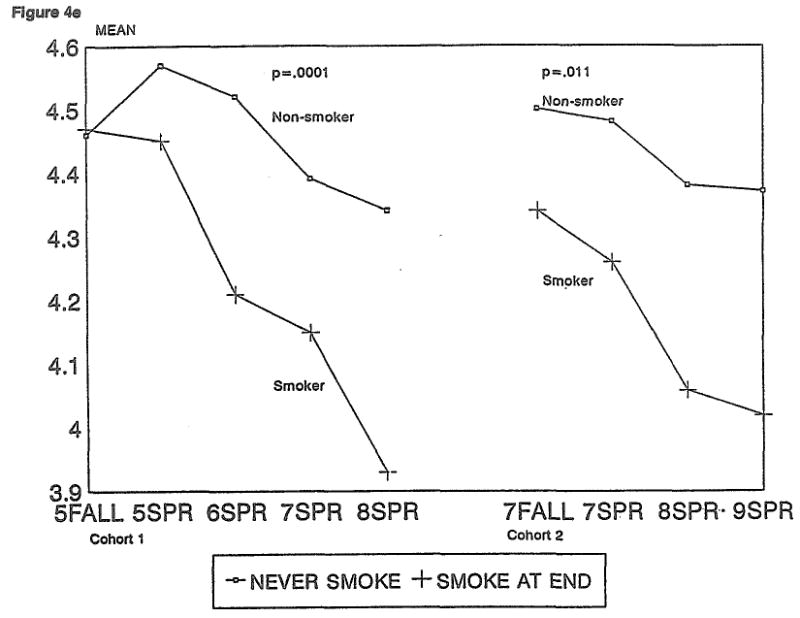
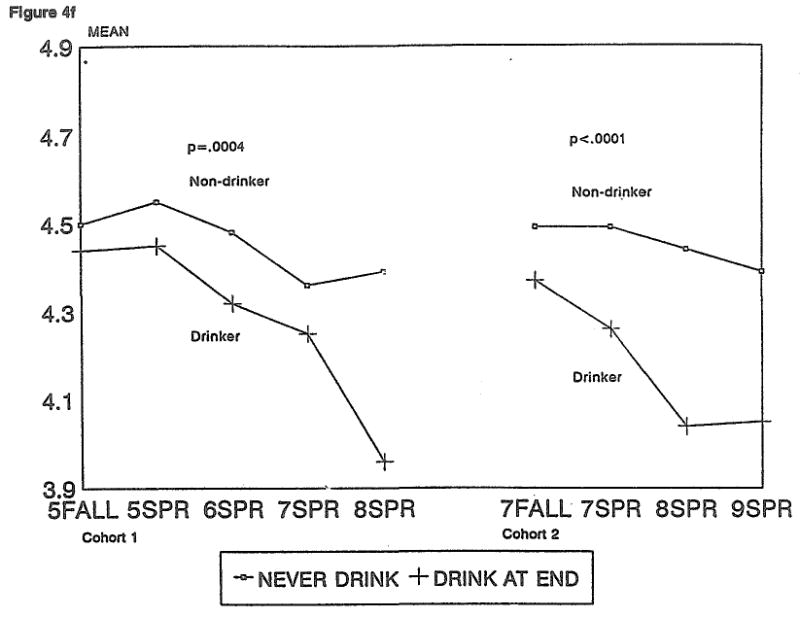
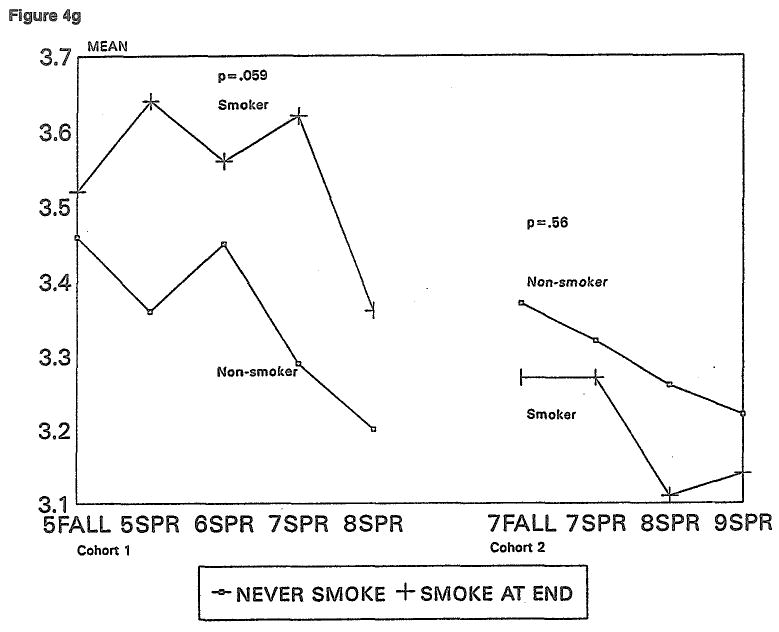
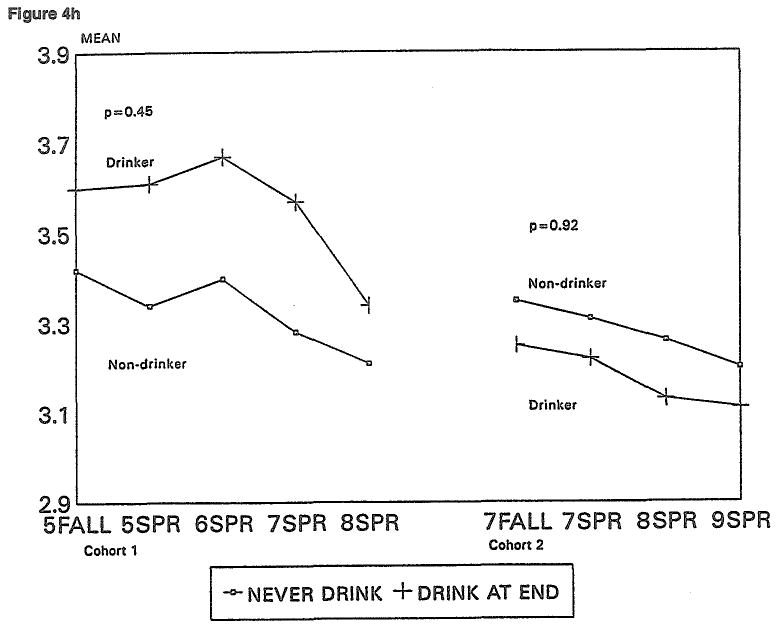
Figure 4a: Student Perception of Parent Respect for Child
Figure 4b: Student Perception of Parent Respect for Child
Figure 4c: Student Perception of Parent-Child Rapport
Figure 4d: Student Perception of Parent-Child Rapport
Figure 4e: Student Perception of Parental Monitoring
Figure 4f: Student Perception of Parental Monitoring
Figure 4g: Student Perception of Parent's Knowledge of Children's Friends
Figure 4h: Student Perception of Parent's Knowledge of Children's Friends
Intentions to Attend Parent Program
When examining parental intentions to attend the parent program with respect to parental assessment of parenting behaviors, parents who perceived higher degrees of rapport, respect, monitoring, and knowledge of children's friends were more likely to report wanting to attend a parent program. Parental assessment of children's risk-taking behavior, however, was not associated with parental intentions to attend a drug prevention program. In Cohort 2, parents whose children reported greater alcohol use were more likely to say they would attend the program (49% who used alcohol compared to 40% who did not use alcohol). Parents who were single and parents who were older were also more likely to say they would attend. Nevertheless, there was no association between age, marital status, or child's substance use with actual attendance. In addition, actual attendance was not associated with relationship to child (mother or father), ethnicity, parent age or education, student gender, parent alcohol use, student smoking, student alcohol use, other parent reports of parenting practices, or student reports of parenting behaviors.
Discussion
We believe the parent-targeted drug prevention program failed to produce changes in adolescent substance use for several reasons. First, even though participation in the intervention was very low, in hindsight, the theoretical model based on the hypothesis that parents could reduce the strongest risk factor—association with substance-using peers—was unrealistic. Parents for the most part did not believe their children's friends used substances and so had no motivation to act as gatekeepers. In all surveys, the parents reported less drug use among students' friends than did the students and the difference between the parents' and students' perceptions increased over time.
The most strongly targeted factor, parents' knowing their children's friends, was not even associated with the onset of substance use. Students' perceptions of the parenting factors monitoring, rapport, and respect were found to be protective against substance use. Although the intervention addressed these briefly, parent perception of the level of monitoring, respect, and rapport among parents whose children used substances was also considerably higher than their children's perceptions. Although it is impossible to say whose perception is the most accurate, the child's perception is the one correlated with substance use. The differential perception of these parenting skills suggests that parents of children who use substances do not have any basis or impetus to improve, because they believe their skills related to monitoring, rapport, and respect are already high. Without awareness that there may be a perception gap, parents are unlikely to make an effort that may alter their children's perception, which may in turn reduce their children's risk of substance use.
Monitoring, a factor measuring parents' knowledge of their children's whereabouts, rather than who they are with, was a protective factor for both tobacco and alcohol use. This factor is likely to be a proxy for concern about the child and may contribute to a child's resilience and capacity to resist peer pressure. The two other parent-related protective factors for substance use, rapport and respect, were mentioned in the intervention but were not the major focus. Instead, parents were encouraged to communicate with other parents in order to monitor their children better. Our experience proved that parents who attended the sessions were very hesitant to discuss other children's behaviors because they feared a negative reaction from those children's parents. Given the current social milieu, at least in these two Los Angeles school districts, a program with a broader and more sustained focus that addresses the entire community rather than individual parents or even small groups of parents would have been more appropriate.
Achieving independence from parents and adopting peer codes and lifestyles are the main tasks of adolescence (Neinstein 1991). In this phase of development, adolescents may not have sufficient alternative emotional support and may be more vulnerable to pressures to use substances. Rapport, a measure of family closeness and communication, was protective possibly because a closer parent-child relationship mitigates the striving for independence or balances external influences to use substances. High parent-child rapport may indicate that children spend less time with peers and relatively more time with adults and have a lower level of exposure to peer pressure. Higher rapport students may take a longer, steadier path to achieving independence.
Early adolescence is also characterized by greater reluctance to accept parental advice or criticism (Neinstein 1991). Respect measures children's perceptions of positive feedback and fairness in the treatment by parents. Respect is protective for substance use probably because this style of management reinforces positive behaviors of youth and helps reinforce the development of identity and ego (Piaget 1948; Erikson 1950; Ginott 1968). This is also consistent with the findings of many other researchers who have found that positive feedback is protective and punitive child-rearing techniques are associated with the development of substance use and deviant behavior (Snyder, Dishion, and Patterson 1986; Patterson and Dishion 1985; Dishion and Loeber 1985; Patterson and Stouthammer-Loeber 1984).
Our study documented that changes in adolescent perception of parenting behavior preceded the onset of adolescent substance use. Prior to the onset of substance use, the levels of parent-child rapport, respect, and parental monitoring were similar among all students. These levels dropped to a greater extent among children who subsequently used substances than among those who did not.
Enhancement of these three protective factors, monitoring, respect, and rapport, appears to be the most promising direction parents can take in preventing adolescent substance use. These factors also are components of the authoritative parenting style defined by Baumrind (1991) and are associated with children's competence and resilience. In our sample, high levels of these factors were also associated with higher academic achievement, as in other studies (Dornbusch et al. 1987; Steinberg, Elmen, and Mounts 1989).
Participation in our program was low, so the challenge remains not only to find an effective intervention but also to find a venue that can reach all parents, particularly those whose children have lower levels of protective forces in their lives. In the forum of an elective after-school evening program, we attracted a minority of families that probably already had high protective factors. Programs labeled “drug prevention” appear to be threatening and stigmatizing to parents. Children whose parents did not respond reported their parents had higher levels of tobacco and alcohol use. Non-attending parents had the perception that their children's level of risky behavior was no higher than that of attending parents. In contrast, the children of nonattending parents reported higher risk behaviors and reported lower monitoring, respect, and rapport indexes.
Because intentions to attend do not translate into actual attendance, a forum that addresses the protective parenting factors and integrates an effective intervention into routine activities, such as in the workplace, or that requires parental participation is more likely to reach the highest risk populations.
Limitations
Attrition of the sample reached 39% by the last year, and analysis of student dropouts indicated that these students had more risk factors for substance use than participating students. This would conservatively bias our study in that eliminating the highest risk students would reduce our ability to measure relationships between parenting behaviors and substance use. The dropout rate was similar in both intervention and control groups so there should not be any impact in determining the effectiveness of the program.
The Future of Parent-Targeted Prevention Programs
Had we been able to intensify our recruitment procedures, we may have had greater participation. However, for most communities with limited educational resources, greater intensity of recruitment is neither feasible nor sustainable. Given the low parental perceptions of the threat of adolescent substance use, and the negative emphasis of the program on drugs together with parents' higher perceptions of the quality of their parent-child relationship, make it doubtful that this type of program could ever elicit the full participation of parents whose children could theoretically benefit the most.
Our findings support the proposal (Brown and Horowitz 1993) that efforts at adolescent substance use prevention, particularly parent involvement, should be reformulated from a risk-reduction approach to a promotion of protective factors. Focusing interventions on the development of healthy relationships and interpersonal interactions could potentially yield benefits beyond substance use prevention. Future programs should consider venues other than voluntary school-based evening programs and sites such as the workplace, social clubs, and shopping malls, and, in particular, integrating parenting skills education into the media should be explored.
Acknowledgments
This research was supported in part by a grant from the National Institute on Alcohol Abuse and Alcoholism, Grant Number 1-R29-AA07360.
Appendix: Parenting-Style Scales
Consistency
If your father says no to something you want, how often does your mother say yes?
If your father says no to something you want, how often do you get him to change his mind?
If your mother says no to something you want, how often does your father say yes?
If your mother says no to something you want, how often do you get her to change her mind?
Internal consistency (α)
| Cohort 1 | Cohort 2 | |
| Student | .65 | .66 |
| Parent | .67 | .70 |
Chores
How often do your parents make you get chores done before you are allowed to do things you really enjoy?
How often do you do chores at home?
Compared to other kids you know, how many chores do you have to do around the house or yard?
Internal consistency (α)
| Cohort 1 | Cohort 2 | |
| Student | .62 | .66 |
| Parent | .62 | .65 |
Parents know your friends
How often do your parents invite your friends to do things with the family?
How much do your parents like your friends?
How much time do your friends spend at your house?
How often do your parents talk to your friends (other than to say hello)?
Internal consistency (α)
| Cohort 1 | Cohort 2 | |
| Student | .63 | .68 |
| Parent | .74 | .76 |
Monitoring
When you go out with your friends, how often do your parents tell you when to be home?
If your parents don't ask where you are going, how often do you tell them?
How often do your parents know where you are when you are not in school?
How often do your parents ask where you are going when you leave the house?
Is it important for your parents to know where you are all the time?
Internal consistency (α)
| Cohort 1 | Cohort 2 | |
| Student | .62 | .70 |
| Parent | .51 | .57 |
Rapport
How much time do you spend talking with your parents?
Do you think you spend enough time with your family?
How often do you share your thoughts or feelings with your parents?
How often do you and your parents do things together that you both enjoy?
How much fun do you have with your parents?
How much of your free time do you spend with one or both of your parents?
Do you ask your parents for their opinion?
Do you tell your parents secrets?
Internal consistency (α)
| Cohort 1 | Cohort 2 | |
| Student | .79 | .84 |
| Parent | .75 | .84 |
Respect
How often do your parents give you praise or encouragement?
Do your parents trust you?
How often do your parents tell you they are proud of you?
How often do your parents criticize you?
Are your parents unfair in the rules they set for you?
Internal consistency (α)
| Cohort 1 | Cohort 2 | |
| Student | .60 | .74 |
| Parent | .56 | .68 |
Peer Drug Use
How many of your best friends use marijuana?
How many of your best friends drink alcohol?
How many of your five best friends have ever been drunk?
How many of your best friends smoke cigarettes?
Internal consistency (α)
| Cohort 1 | Cohort 2 | |
| Student | .78 | .86 |
| Parent | .52 | .69 |
Student Risk Taking
Is it worth getting into trouble to have a little fun?
Do you like to do things that are dangerous?
In the past year have you been sent out of a classroom by a teacher for bad behavior?
In the past year have you been in a physical fight?
How often do you do things you've been told not to do?
Internal consistency (α)
| Cohort 1 | Cohort 2 | |
| Student | .61 | .71 |
| Parent | .56 | .87 |
Contributor Information
Deborah A. Cohen, assistant professor with the Departments of Health Systems Research and Public Health and Medicine at the Louisiana State University Medical Center in New Orleans
Janet C. Rice, associate professor of biostatistics at Tulane University School of Public Health and Tropical Medicine
References
- Albert WG, Simpson RI, Eaglesham JA. Evaluation of a drinking and parenting educational program in six Ontario communities. Journal of Drug Education. 1983;13(4):327–35. [Google Scholar]
- Bangert-Drown RL. The effects of school-based substance abuse education—a meta-analysis. Journal of Drug Education. 1988;18:243–65. doi: 10.2190/8U40-WP3D-FFWC-YF1U. [DOI] [PubMed] [Google Scholar]
- Baumrind D. The influence of parenting style on adolescent competence and substance use. Journal of Early Adolescence. 1991;11:56–95. [Google Scholar]
- Botvin GJ, Wills T. Personal and social skills training, Cognitive-behavioral approaches to substance abuse prevention. In: Bell C, Battjes R, editors. Prevention research deterring drug abuse among children and adolescents. Washington, DC: U.S. Government Printing Office; 1985. pp. 8–49. NIDA Research Monograph No. 56 DHHS Publication No. ADM 85-1. [PubMed] [Google Scholar]
- Brown JH, Horowitz JE. Deviance and deviants. Evaluation Review. 1993;17(5):520–55. [Google Scholar]
- DeMarsh J, Kumpfer K. Family-oriented interventions for the prevention of chemical dependency in children and adolescents. Journal of Children in Contemporary Society. 1985;18(1 & 2):117–51. [Google Scholar]
- Dishion TJ, Loeber R. Adolescent marijuana and alcohol use: The role of parents and peer revisited. American Journal of Drug and Alcohol Abuse. 1985;11(1 & 2):11–25. doi: 10.3109/00952998509016846. [DOI] [PubMed] [Google Scholar]
- Dornbusch SM, Ritter PL, Leiderman PH, Roberts DF, Fraleigh MJ. The relation of parenting style to adolescent school performance. Child Development. 1987;58:1244–57. doi: 10.1111/j.1467-8624.1987.tb01455.x. [DOI] [PubMed] [Google Scholar]
- Erikson E. Childhood and society. New York: Norton; 1950. [Google Scholar]
- Flay BR. Social psychological approaches to smoking prevention: Review and recommendations. Advances in Health Education and Promotion. 1987;2:121–80. [Google Scholar]
- Ginott H. Between parent and child. New York: Avon Books; 1968. [Google Scholar]
- Hansen WB, Graham JW, Sobel JL, Shelton DR, Flay BR, Johnson CA. The consistency of peer and parent influences on tobacco, alcohol, and marijuana use among young adolescents. Journal of Behavioral Medicine. 1987;10:559–79. doi: 10.1007/BF00846655. [DOI] [PubMed] [Google Scholar]
- Hansen WB, Johnson CA, Flay BR, Graham JW, Sobel J. Affective and social influences approaches to the prevention of multiple substance abuse among seventh grade students: Results from Project SMART. Preventive Medicine. 1988;17:135–54. doi: 10.1016/0091-7435(88)90059-x. [DOI] [PubMed] [Google Scholar]
- Klein MA, Swisher JD. A statewide evaluation of a communication and parenting skills program. Journal of Drug Education. 1983;13(1):73–82. [Google Scholar]
- Klitzner M, Gruenewald PJ, Bamberger E. The assessment of parent-led prevention programs: A preliminary assessment of impact. Journal of Drug Education. 1990;20(1):77–94. doi: 10.2190/BMB6-7CEE-XUHT-KMEE. [DOI] [PubMed] [Google Scholar]
- Laudeman KA. Seventeen ways to get parents involved in substance abuse education. Journal of Drug Education. 1984;14(4):307–13. doi: 10.2190/J55Y-5248-6PD2-ETH0. [DOI] [PubMed] [Google Scholar]
- MacKinnon DP, Johnson CA, Pentz MA, Dwyer JH, Hansen WB, Flay BR, Wang EY. Mediating mechanisms in a school-based drug prevention program: First year effects of the Midwestern Prevention Project. Health Psychology. 1991;10(3):164–72. doi: 10.1037//0278-6133.10.3.164. [DOI] [PubMed] [Google Scholar]
- McAlister AL, Perry C, Maccoby N. Adolescent smoking: Onset and prevention. Pediatrics. 1979;63:650–58. [PubMed] [Google Scholar]
- Neinstein L. Chap 2 in Adolescent health care: A practical guide. 2d. Baltimore: Urban and Schwarzenberg; 1991. Psychosocial development in normal adolescents. [Google Scholar]
- Patterson GR, Dishion TJ. Contributions of families and peers to delinquency. Criminology. 1985;23(1):63–79. [Google Scholar]
- Patterson GR, Stouthammer-Loeber M. The correlation of family management practices and delinquency. Child Development. 1984;55:1299–1307. [PubMed] [Google Scholar]
- Pentz MA, Dwyer J, MacKinnon DPP, Flay BR, Hansen WB, Wang E, Johnson CA. A multi-community trial for primary prevention of adolescent drug abuse: Effects on drug use prevalence. Journal of the American Medical Association. 1989;261:3259–66. [PubMed] [Google Scholar]
- Piaget J. The moral judgement of the child. Glencoe, Illinois: Free Press; 1948. [Google Scholar]
- Pulkininen L. Youthful smoking and drinking in a longitudinal perspective. Journal of Youth and Adolescence. 1983;12(4):253–83. doi: 10.1007/BF02088726. [DOI] [PubMed] [Google Scholar]
- Shedler J, Block J. Adolescent drug use and psychologic health, a longitudinal inquiry. American Psychologist. 1990;45(5):612–30. doi: 10.1037//0003-066x.45.5.612. [DOI] [PubMed] [Google Scholar]
- Snyder J, Dishion TJ, Patterson GR. Determinants and consequences of associating with deviant peers during preadolescence and adolescence. Journal of Early Adolescence. 1986;6(1):29–43. [Google Scholar]
- Steinberg L, Elmen JD, Mounts NS. Authoritative parenting, psychosocial maturity, and academic success among adolescents. Child Development. 1989;60(6):1424–36. doi: 10.1111/j.1467-8624.1989.tb04014.x. [DOI] [PubMed] [Google Scholar]


